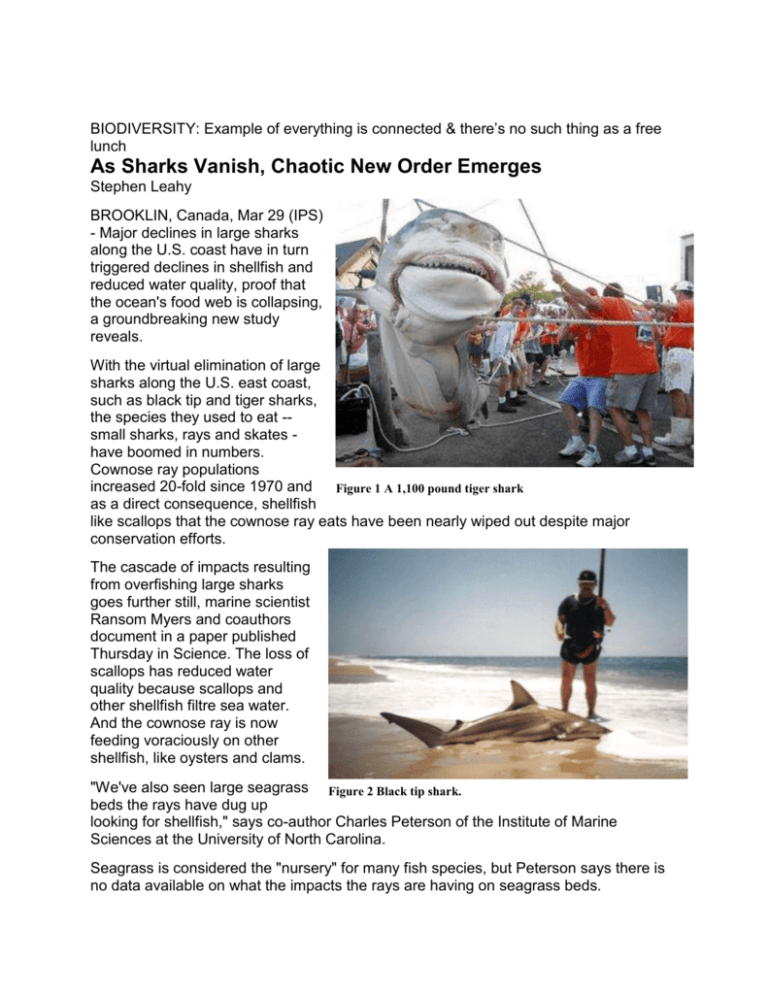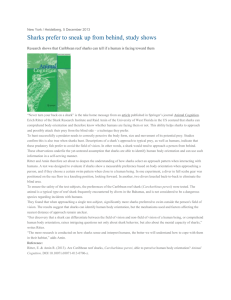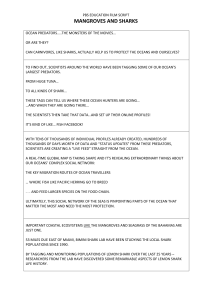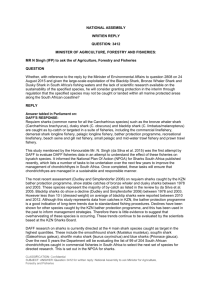
BIODIVERSITY: Example of everything is connected & there’s no such thing as a free
lunch
As Sharks Vanish, Chaotic New Order Emerges
Stephen Leahy
BROOKLIN, Canada, Mar 29 (IPS)
- Major declines in large sharks
along the U.S. coast have in turn
triggered declines in shellfish and
reduced water quality, proof that
the ocean's food web is collapsing,
a groundbreaking new study
reveals.
With the virtual elimination of large
sharks along the U.S. east coast,
such as black tip and tiger sharks,
the species they used to eat -small sharks, rays and skates have boomed in numbers.
Cownose ray populations
increased 20-fold since 1970 and
Figure 1 A 1,100 pound tiger shark
as a direct consequence, shellfish
like scallops that the cownose ray eats have been nearly wiped out despite major
conservation efforts.
The cascade of impacts resulting
from overfishing large sharks
goes further still, marine scientist
Ransom Myers and coauthors
document in a paper published
Thursday in Science. The loss of
scallops has reduced water
quality because scallops and
other shellfish filtre sea water.
And the cownose ray is now
feeding voraciously on other
shellfish, like oysters and clams.
Figure 1 black tip shark
"We've also seen large seagrass Figure 2 Black tip shark.
beds the rays have dug up
looking for shellfish," says co-author Charles Peterson of the Institute of Marine
Sciences at the University of North Carolina.
Seagrass is considered the "nursery" for many fish species, but Peterson says there is
no data available on what the impacts the rays are having on seagrass beds.
The cownose ray is just one of 12 species of rays, skates and small sharks that have
sharply increased in numbers.
"We have no idea what impacts the other 11 are having," Peterson told IPS. "What we
do know from this study is that sharks play a crucial role in the ocean ecosystem."
Sharks are the ocean's "king of the beasts", the top or apex predator. Ecologists have
learned that top predators perform an important role of stabilising ecosystems. Their
removal produces what's termed a "trophic cascade". For example, sharp declines of
sea otters on the North American west coast resulted in a boom of the otter's favourite
food, sea urchins, which in turn led to major declines in kelp forests. Kelp forests are
another kind of important nursery for many marine species.
Going the other way, reintroducing wolves, the top predator, into Yellowstone Park
reduced populations of elk and moose. That led to a resurgence in plants and tree
growth along streams and rivers, benefiting birds and other species, according to Jim
Estes, a marine ecologist at the University of California.
"Wolves may help buffer ecosystems from climate change, according to some recent
research," Estes told IPS last year. "On land, many of top predators are gone but the
oceans still have all the pieces if we stop exploiting them."
Those pieces, and especially the top predators, are now going fast.
In 2003, Ransom Myers and Julia Baum of Canada's Dalhousie University documented
that more than 90 percent of all large predatory fish in the world's oceans were gone,
mainly due to overfishing. They warned that this loss of the entire top of the ocean food
chain would unbalance ocean ecosystems.
"We have literally chopped off the top of the ocean food web," Baum said told IPS. "As a
result, there is a massive restructuring (of the food web) going on."
This current study is perhaps the first ever documentation of the cascading impacts of
the loss of large sharks because ocean food webs are so complex and there is little
data.
"There is little doubt this is kind of thing is happening in other coastal regions of the
world," Baum said.
She noted that Japanese scientists have found that large increases in eagle ray
populations are responsible for wiping out their natural and aquaculture shellfish beds,
but are puzzled as to why.
"It should not be a surprise given the massive decline in sharks that feed on rays," she
said.
Shark finning has become the major reason for the decline. Fishers net sharks, slice off
the fins, then throw the bleeding, limbless fish back into the water. Shark fins are the
primary ingredient in shark-fin soup, a 100-dollar staple of Chinese restaurants
throughout Asia and parts of the West.
"Shark finning is a huge industry and it's out of control," Baum said.
Demand is growing at more than five percent a year and efforts to ban the practice have
not been effective, she added. Some reports place the value of shark fins and shark
cartilage used in traditional medicines to treat joint pain at a trillion dollars a year.
Indeed, there isn't a drug store in North America that doesn't have products with shark
cartilage -- despite the lack of proof of any medicinal benefits.
Not only lucrative, finning is a low-tech industry that doesn't even require boats with
refrigeration, since the fins are dried. Unfortunately, sharks cannot recover from these
losses because they are a slow-growing species, maturing in 20 or more years and
having relatively few young.
The United States and Canada placed bans on finning in the early 1990s, while 60 other
countries have agreed to ban the practice in the Atlantic Ocean. Mexico announced a
ban this month.
But these bans are not only hard to enforce, they often are not really bans at all, says
Baum. Instead, finning is deemed acceptable as long the body of the shark is taken as
well.
The escalating demand for shark fins and cartilage is producing a catastrophic decline
in the numbers of sharks around the world. One major step is to reduce public demand
for shark products through education.
The other is to have a complete and absolute ban on catching large coastal sharks,
says Peterson.
"The results of our study should be taken very seriously," he said. (END/2007)
Copyright © 2007 IPS-Inter Press Service. All rights reserved.
***
http://www.terradai ly.com/reports/ Over_Fishing_ Of_Atlantic_
Sharks_Upsets_Ecosystem_ Balance_999. html
Over-Fishing Of Atlantic Sharks Upsets Ecosystem Balance
The numbers of scalloped hammerhead
(pictured) and tiger sharks appear to have
declined by more than 97 percent over that
period, while populations of bull, dusky and
smooth hammerhead sharks could be down as
much as 99 percent, according to this analysis.
by Staff Writers
Chicago (AFP) March 29, 2007
The virtual elimination of large sharks from
coastal waters off the US eastern seaboard has disturbed the marine ecosystem, and
wiped out one US bay scallop fishery, a study released Thursday said.
The massive over-fishing of the largest predatory sharks in the coastal waters of the
Atlantic over the past 30-some years has led to an explosion in the ray, skate and small
shark species that they prey on, with devastating effects for one of the organisms at the
bottom of the food chain.
"Large sharks have been functionally eliminated from the east coast of the US, meaning
that they can no longer perform their ecosystem role as top predators," said Julia Baum,
a doctoral student at Dalhousie University in Halifax, Canada and co-author of the
paper.
"With fewer sharks around, the species they prey upon -- like cownose rays -- have
increased in numbers, and in turn, hordes of cownose rays dining on bay scallops have
wiped the scallops out."
Several of the larger shark species in the northwest Atlantic are verging on extinction,
according to Baum and colleagues who analyzed a dozen surveys dating from 1970 up
to 2005.
The numbers of scalloped hammerhead and tiger sharks appear to have declined by
more than 97 percent over that period, while populations of bull, dusky and smooth
hammerhead sharks could be down as much as 99 percent, according to this analysis.
The reasons are not hard to find, say the marine biologists. The growing demand for
shark fins and shark meat, particularly in Asia, has led to a rapid escalation in sharkfishing.
With the drop in shark population, a dozen species of rays, skates and small sharks
have increased in numbers over the past 16 to 35 years, some of them tenfold,
according to other data reviewed by the marine biologists.
Perhaps the most conspicuous beneficiary of the decline in shark numbers is the east
coast cownose ray, whose numbers have exploded, rising an average of eight percent a
year to bring the total population to an estimated 40 million, according to the study in the
journal Science.
The rays feed on mollusks including bay scallops, oysters, and soft-shell and hard
clams. The boom in cownose ray numbers has been nothing short of a disaster for
North Carolina's bay scallop fishermen.
In the early 1980s, researchers who sampled the bay scallops in the North Carolina
sounds before and after the rays' annual summer feeding session, found their numbers
were sufficient to sustain a commercial fishery and still replenish themselves every year.
By 1996, the migrating rays were consuming nearly all of the scallops in the area by
early fall, except those protected by fences the researchers had put up to keep the rays
out.
By 2004, the fishermen who harvested the scallops had gone out of business, ending a
century-old North Carolina tradition.
"This is just a small window into this domino effect," said Charles Peterson, a professor
at the Institute of Marine Sciences, University of North Carolina at Chapel Hill and coleader of the study.
The effects on the ecosystem of increases in the other rays, skate and smaller shark
species is still unclear, but there may be a cascade effect there too, the authors of the
paper said.
"Our study provides evidence that the loss of great sharks triggers changes that
cascade throughout coastal food webs," said Baum.
"Solutions include enhancing protection of great sharks by substantially reducing fish
pressure on all of these species and enforcing bans on shark finning both in national
waters and on the high seas."
Source: Agence France-Presse
*** NOTICE: In accordance with Title 17 U.S.C. Section 107, this material is distributed,
without profit, for research and educational purposes only. ***








